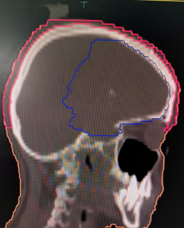Scalp dosimetry as a predictor of radiation-induced alopecia in primary brain tumours: a retrospective study from a tertiary cancer centre in south India
Keywords:
Scalp dosimetry, Radiotherapy-induced alopecia, Primary brain tumours, VMAT, QOLAbstract
Introduction: Radiotherapy is essential in treating primary brain tumours, but radiation-induced alopecia (RIA) remains a common side effect that significantly affects patients' quality of life (QOL). With its psychosocial impact on self-image, emotional well-being, and social interactions, alopecia warrants focused attention. This study aims to evaluate the scalp as an organ at risk by defining dose constraints that minimize RIA while maintaining optimal target coverage.
Materials and methods: A retrospective analysis was conducted on 70 patients with primary brain tumours who received focal cranial radiotherapy between January 2022 and December 2024. Scalp dose-volume histograms (DVHs) were generated from treatment planning systems, and the mean scalp dose (D mean), maximum scalp dose (D max), median volume of scalp, volume of scalp receiving ≥ 30 Gy (V30Gy), dose received by 20cc (D20cc), and 30cc (D30cc) scalp volume were recorded. RIA was graded according to the Common Terminology Criteria for Adverse Events (CTCAE) version 5.0. ROC statistical analysis was performed to evaluate the predictive value of scalp dosimetric parameters for RIA severity.
Results: The median age of the cohort was 57 years, with a male-to-female ratio of 1.08:1. The median D max, D mean, V 30 Gy, D20cc were 60.4 Gy, 17.5 Gy, 19.2%, and 46.4 Gy, respectively. Grade 2 and higher RIA was observed in 63% of patients. V30Gy, either independently or in combination with Scalp D mean, was identified as a significant predictor of Grade 2 or higher RIA.
Conclusion: Optimising scalp dose parametric during radiotherapy planning may help mitigate RIA and improve QOL.

Additional Files
Published
How to Cite
License
Copyright (c) 2025 Lalitha Nageshwari S, Govardhan HB, Ibrahim Khaleel, Vijayath BR, Akshay KT, Priyadarshini T, Sahana R

This work is licensed under a Creative Commons Attribution-NonCommercial 4.0 International License.
